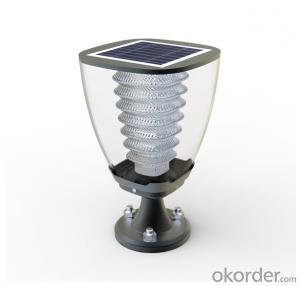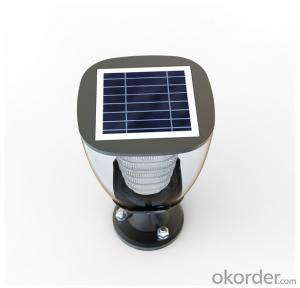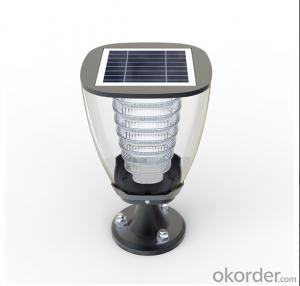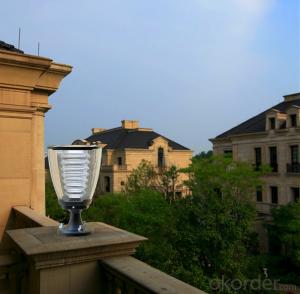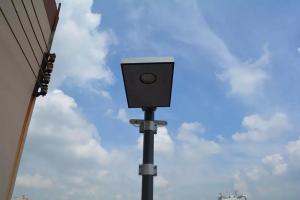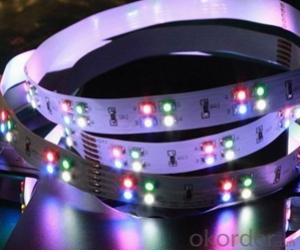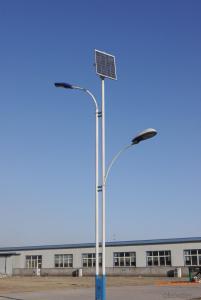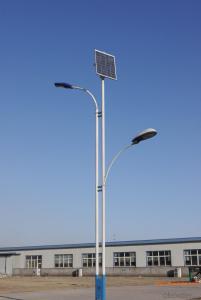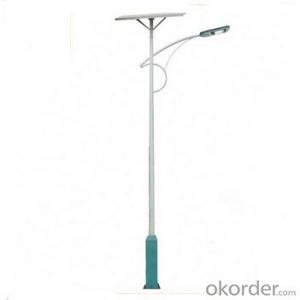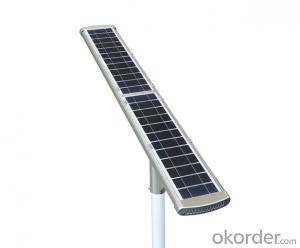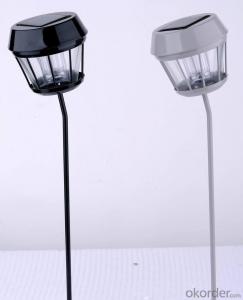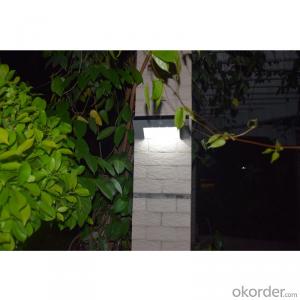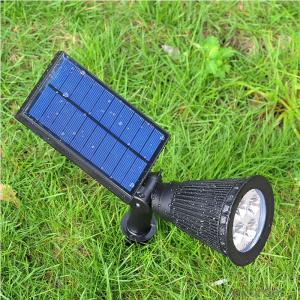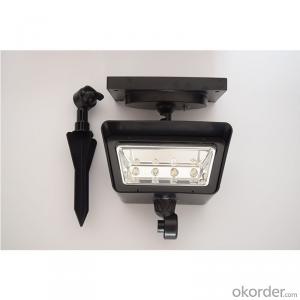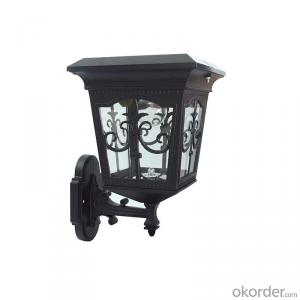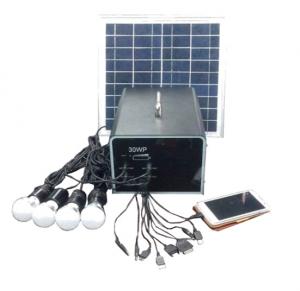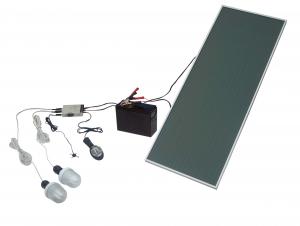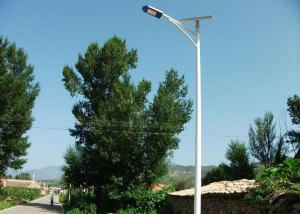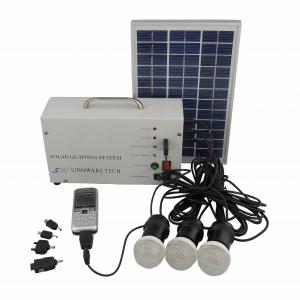Exterior Solar Light - Solar Garden Pillar Light Warm White Lighting for Decorating
- Loading Port:
- China main port
- Payment Terms:
- TT OR LC
- Min Order Qty:
- 100 set
- Supply Capability:
- 10000 set/month
OKorder Service Pledge
OKorder Financial Service
You Might Also Like
Features:
Elegant CUP design
Warm white lighting for decorating
Stainless Aluminum body
100% solar powered, wireless connection
Superbright LEDs,100Lumens
Over 2 nights long lighting time, Waterproof IP65
Specification | ||
Solar panel | 1.6W,17% efficiency | 10 years |
Li-ion battery | 3.7V 2000mAh | 500 cycles |
LED | 1W, 100lm, Warm white | 50,000Hrs |
Ray sensor | <10Lux | |
Lighting mode | 5Hrs high bright + 7 Hrs dim light | Switch timer |
material | Aluminum + ABS | |
Solar charging time | 7~8 hours by bright sunlight | 1000W/m2 |
Lighting time | Around 3 nights | Full charged |
Efficiency | >85% | |
Product size | 264mm(H)*dia160mm | Unit:mm |
Product Application Area:
Courtyard/Garden
Park
Roadway/pathway
Parking Lot
Private road
Sidewalk
Public square/ plaza

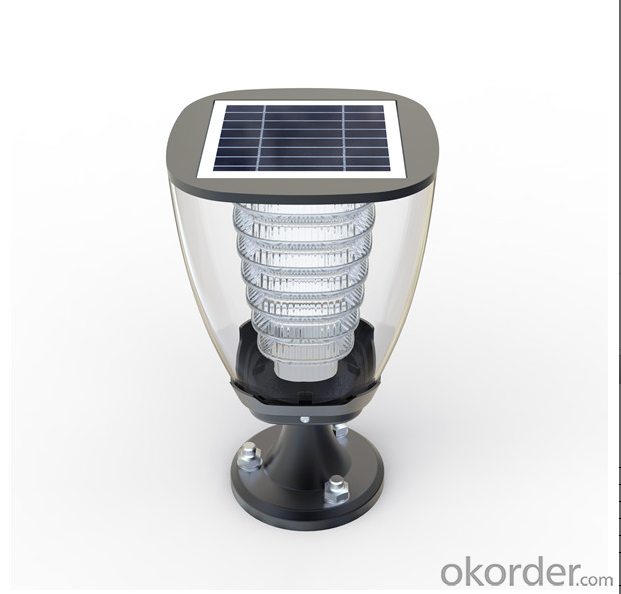

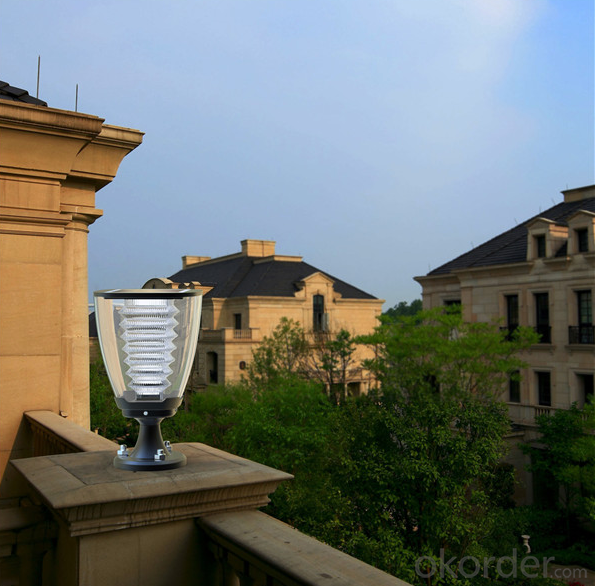


FAQ
1.How to install?
You can fix the product with the screw in the packing box and install the product on the area that needs illumination. Enough sunshine that can insolate the solar panel for charging has to be ensured. You have to pay attention that excellent effect of charging can be achieved when the solar panel has angle and no shelter and faces to the south area.
2.How to use and how to charge?
The product is off before delivery in order to avoid discharging during transportation. You can activate it by using the pin, take away the magnet, and face the solar panel to the sunlight or tearing off the film. This is depend on different item, the activate way may differ. Solar panel should be insolated with certain angle and charge in the daytime and bright automatically in the nighttime.
3.Dose the light illuminate in the daytime?
The light is optically controlled. It will not illuminate when there is enough light during the day. Once night falls, it will bright.
4.How is the effect of the PIR motion sensor?
The light will be in the energy saving mode when it is dark automatically, light will be off when it is dawn. With this characteristic, the light can be used as signal light, indicator light and continuous light.
PIR motion sensor light: Entering into the induction area when it is dark, the light will bright automatically and lasts for about 30 seconds, and then, it will turn to power saving mode.
- Q: How do solar lights handle strong winds or storms?
- Solar lights are designed to withstand strong winds and storms to a certain extent. Most solar lights are built with durable materials such as weather-resistant plastic or metal, ensuring they are sturdy and can endure harsh weather conditions. They often come with a stake or base that can be securely anchored into the ground, providing stability during windy conditions. Additionally, solar lights are generally equipped with a waterproof and sealed casing to protect the internal components and solar panels from rain, snow, and other elements. This helps ensure their functionality and longevity even during storms. However, it is important to note that extremely severe weather conditions, such as hurricanes or tornadoes, can potentially damage solar lights just like any other outdoor structures. In such cases, it is advisable to take precautionary measures by removing the lights temporarily or securing them indoors until the storm passes. Overall, while solar lights are designed to withstand typical winds and storms, it is always wise to consider the severity of the weather and take appropriate actions to protect them whenever necessary.
- Q: Can solar lights be used for parking lots or garages?
- Indeed, parking lots or garages can definitely make use of solar lights. In fact, these lights are gaining popularity for such applications due to their various advantages. Solar lights are powered by sunlight, eliminating the need for electrical wiring or connections to the grid. This makes their installation simple and eliminates the expenses associated with trenching or digging. Furthermore, solar lights are highly efficient as they convert sunlight into electricity using photovoltaic panels. They store this energy in built-in batteries during the day and utilize it to power the lights at night. This not only reduces electricity costs but also helps in reducing the carbon footprint and promoting environmental sustainability. In terms of parking lots and garages, solar lights provide reliable illumination throughout the area. They emit bright light to ensure better visibility and safety for vehicles and pedestrians. Some solar lights even have motion sensors, which are particularly useful in deterring theft or vandalism in parking lots or garages. Additionally, solar lights offer flexibility in terms of placement. Since they do not rely on a traditional power source, they can be installed in any location that receives sufficient sunlight, regardless of proximity to electrical outlets. This allows for greater versatility in the design of lighting layouts, ensuring optimal coverage for the parking lot or garage. Overall, solar lights are a cost-effective, environmentally friendly, and practical solution for lighting parking lots and garages. They offer the convenience of easy installation, energy-efficient operation, improved safety, and reduced maintenance requirements. With advancements in solar technology, these lights have become a reliable and sustainable alternative to traditional electric lighting options.
- Q: Can solar lights be used for outdoor markets or food stalls?
- Yes, solar lights can be used for outdoor markets or food stalls. They are a sustainable and cost-effective lighting solution that can provide illumination during evening hours without the need for electricity. This makes them ideal for outdoor settings where access to power sources may be limited. Additionally, solar lights are easy to install, require minimal maintenance, and can enhance the visibility and safety of outdoor markets or food stalls after dark.
- Q: Do solar lights have a built-in power backup system?
- No, solar lights typically do not have a built-in power backup system. They rely solely on the energy collected from the sun during the day to power the lights at night.
- Q: Can solar lights be used as a primary lighting source?
- In certain circumstances, solar lights can serve as the main source of lighting, but this is dependent on various factors. Sunlight powers solar lights, meaning they must have direct exposure to the sun to charge their batteries. Because of this, they are ideal for outdoor spaces like gardens, pathways, and parking lots, where they can capture a sufficient amount of sunlight throughout the day. However, there are limitations to relying solely on solar lights for primary lighting. Firstly, their performance is greatly affected by weather conditions. Cloudy or rainy days can decrease the amount of sunlight available for charging, resulting in reduced lighting output at night. Additionally, solar lights generally have lower brightness levels compared to traditional lighting sources, making them unsuitable for areas that require high levels of illumination, such as workspaces or large indoor rooms. When determining whether solar lights can be used as the primary lighting source, it is important to take into account the specific lighting needs and conditions of the area in question. In some cases, it may be more practical to combine solar lights with other lighting options, such as grid-powered lights or battery-powered lights, to ensure consistent and reliable illumination.
- Q: Can solar lights be used for outdoor seating areas or cafes?
- Yes, solar lights can definitely be used for outdoor seating areas or cafes. In fact, they are a popular choice for these settings due to their numerous benefits. Solar lights are powered by sunlight, which means they do not require any electrical wiring or outlets, making them easy to install and move around. This is particularly advantageous for outdoor seating areas or cafes where installing traditional lights may be challenging or costly. Additionally, solar lights are energy-efficient, as they store sunlight during the day and automatically illuminate at night, helping to reduce electricity consumption and overall costs. They also come in various designs and styles, allowing you to choose the ones that best match the ambiance and aesthetic of your outdoor seating area or cafe. Overall, solar lights are a practical, eco-friendly, and aesthetically pleasing lighting solution for outdoor spaces.
- Q: What are the benefits of using solar lights?
- There are several benefits of using solar lights. Firstly, solar lights are environmentally friendly as they harness energy from the sun, a renewable source, reducing the reliance on non-renewable energy sources. Secondly, they are cost-effective in the long run as they require minimal maintenance and do not add to electricity bills. Additionally, solar lights are easy to install and can be placed in remote areas without the need for extensive wiring. Lastly, they provide increased safety and security by illuminating outdoor spaces, pathways, and driveways, thereby deterring potential intruders.
- Q: How do you choose the right solar lights for your needs?
- When choosing the right solar lights for your needs, consider factors such as the intended purpose, location, brightness, and design. Determine whether you need solar lights for security, accent lighting, or pathway illumination. Assess the amount of sunlight your chosen location receives to ensure optimal charging. Check the brightness level and color temperature to match your preferences and requirements. Lastly, select a design that complements your outdoor aesthetics.
- Q: Can solar lights be used for lighting up outdoor art installations or exhibits?
- Yes, solar lights can be used for lighting up outdoor art installations or exhibits. Solar lights are a great eco-friendly option for outdoor lighting as they harness sunlight to generate power, eliminating the need for electricity or wiring. They can provide sufficient illumination to highlight and enhance the beauty of art installations or exhibits during nighttime hours. Additionally, solar lights are easy to install, cost-effective, and require minimal maintenance, making them an ideal choice for outdoor art lighting.
- Q: Do solar lights have adjustable color temperature?
- No, solar lights typically do not have adjustable color temperature. They are designed to emit a specific color of light, usually a cool white or warm white, which is determined by the built-in LED bulb.
Send your message to us
Exterior Solar Light - Solar Garden Pillar Light Warm White Lighting for Decorating
- Loading Port:
- China main port
- Payment Terms:
- TT OR LC
- Min Order Qty:
- 100 set
- Supply Capability:
- 10000 set/month
OKorder Service Pledge
OKorder Financial Service
Similar products
Hot products
Hot Searches
Related keywords
